
From the Adriatic to Europe's Heart: Exploring Croatia, Budapest, and Prague
 10 Day Tour of Split, Zagreb, Budapest and Prague
10 Day Tour of Split, Zagreb, Budapest and Prague
Overview
Trip Map
Itinerary
Inclusions
Reviews







10 Days 9 Nights
Best Time: Jan-Dec
Cultural Exploration
History Buffs
Take an enchanting trip from the Adriatic Sea to the heart of Europe, exploring some of Central Europe’s most scenic & historic cities. Start in Split, where the remnants of Diocletian's Palace transport you back to Roman times. Wander charming medieval lanes in Zagreb and discover why Croatia’s capital is one of Europe’s hottest new destinations. In Budapest, marvel at the stunning Buda Castle and unwind in historic thermal baths. Conclude in Prague, where Prague Castle and the medieval town of Kutná Hora await. With private guided tours and detailed travel guidance through our mobile app, you’ll enjoy stress-free authentic discovery.
- Explore the Roman emperor Diocletian's Palace and wander the Venetian alleyways of Split's Old Town.
- Tour Zagreb's historic neighborhoods of Kaptol and Gradec with a private guide.
- Enjoy panoramic views from Budapest's Buda Castle and relax in the historic Gellért and Rudas baths.
- Follow the Royal Route to the majestic Prague Castle, the largest castle complex in Europe.
- Take an excursion to the medieval Kutná Hora, renowned for its history and striking "bone church".
Take an enchanting trip from the Adriatic Sea to the heart of Europe, exploring some of Central Europe’s most scenic & historic cities. Start in Split, where the remnants of Diocletian's Palace transport you back to Roman times. Wander charming medieval lanes in Zagreb and discover why Croatia’s capital is one of Europe’s hottest new destinations. In Budapest, marvel at the stunning Buda Castle and unwind in historic thermal baths. Conclude in Prague, where Prague Castle and the medieval town of Kutná Hora await. With private guided tours and detailed travel guidance through our mobile app, you’ll enjoy stress-free authentic discovery.
- Explore the Roman emperor Diocletian's Palace and wander the Venetian alleyways of Split's Old Town.
- Tour Zagreb's historic neighborhoods of Kaptol and Gradec with a private guide.
- Enjoy panoramic views from Budapest's Buda Castle and relax in the historic Gellért and Rudas baths.
- Follow the Royal Route to the majestic Prague Castle, the largest castle complex in Europe.
- Take an excursion to the medieval Kutná Hora, renowned for its history and striking "bone church".

Diocletian’s Palace
Castles & Chateaux

Bačvice Beach
Natural Beauty

Old Town
Architecture

Lower Town
Architecture

Hungarian Parliament
Architecture

National Museum
Museums & Galleries

Central Market
Street Markets

Castle Hill
Castles & Chateaux

Prague Castle
Castles & Chateaux
Must see sights

Diocletian’s Palace
Castles & Chateaux

Bačvice Beach
Natural Beauty

Old Town
Architecture

Lower Town
Architecture

Hungarian Parliament
Architecture

National Museum
Museums & Galleries

Central Market
Street Markets

Castle Hill
Castles & Chateaux

Prague Castle
Castles & Chateaux
Starting from
$1749
per person
 Not included
Not included Secure Your Customizable Trip
Enter your details to embark on a journey that can be tailored just for you.
Start
Travelers
0 travelers
Add Room
Remove Room
Preferred Hotel Stars
Select Hotel Stars
Craft Your Own Itinerary
Select your interests and destinations for a trip plan inspired by you.
Trip Map & Itinerary
Enable/Disable Map Scrolling
Click To Make Map Interactive

Trip Timeline
 Edit Details
Edit DetailsArrival
3 nights
Split
Croatia
Train: 6.5h
1 nights
Zagreb
Croatia
Train: 6h
2 nights
Budapest
Hungary
Train: 7h
3 nights
Prague
Czech Republic
Departure
Day-By-Day Itinerary
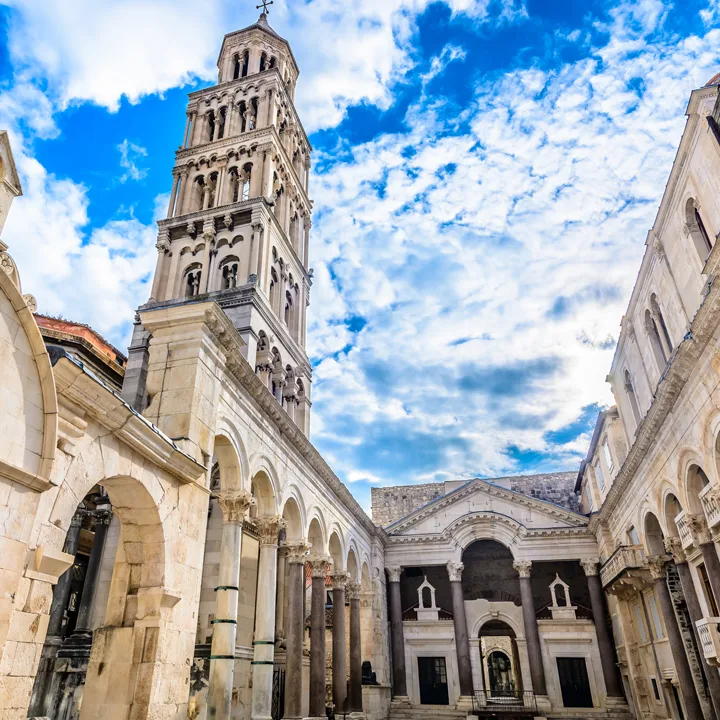
Day 1
Arrive Split
Day 1
Arrive Split


To Be Determined
Arrival in Split and Private Transfer to Hotel from Airport
We will schedule a pick up for 15 minutes after your flight's arrival time. You will be met in the terminal by an English speaking driver holding a sign with your name on it. The ride is for your party only - you will not be sharing a vehicle. The cost of the ride will be included in your itinerary package. IMPORTANT NOTE: Please be aware the car service can fit up to 1 checked item of luggage and 1 personal item per person, such as a purse or small backpack. If you think you will have more baggage, please inform your travel consultant as this may result in an additional fee.

Day 1
Arrive Split


Day 1
Arrive Split



To Be Determined:
Arrival in Split and Private Transfer to Hotel from Airport
Mid-Day/Afternoon:
Diocletian's Palace

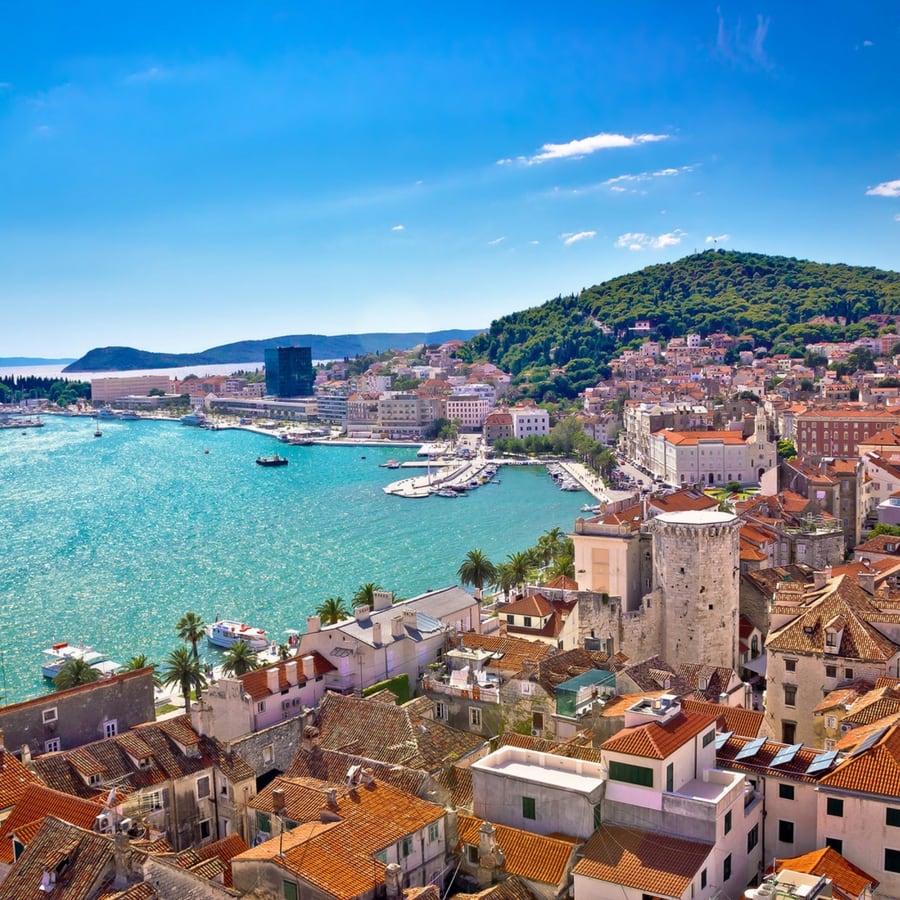
Day 2
Split
Day 2
Split



9:00 AM - 11:00 AM
Walking Tour of Split Old Town & Diocletian's Palace
This two-hour guided tour will take you to the Roman emperor Diocletian's 1700-year-old palace which was built as his personal rest home. Walk from the Bronze Gate through the central hall of the ancient cellars is the main communication line between the busy waterfront promenade, the Riva, and the palace's main forecourt, the Peristyle. You'll also stop by the Cathedral of St Duje, one of the most beautiful cultural attractions on the Adriatic coast, the Roman temple of Jupiter (latterly a Christian baptistry), the fabulous Golden Gate, and the medieval Croatian bishop who introduced the Croatian language in religious services.

Peristyle
See the beautiful courtyard which was once the center of the palace, and is now the heart of Split.
Show More

Bronze Gate and Palace Cellars
Enter this ancient gateway to discover palace cellars used as film sets for Game of Thrones.
Show More

Peristyle
See the beautiful courtyard which was once the center of the palace, and is now the heart of Split.
Show More

Bronze Gate and Palace Cellars
Enter this ancient gateway to discover palace cellars used as film sets for Game of Thrones.
Show More

Peristyle
See the beautiful courtyard which was once the center of the palace, and is now the heart of Split.
Show More

Bronze Gate and Palace Cellars
Enter this ancient gateway to discover palace cellars used as film sets for Game of Thrones.
Show More
prev
next

Day 2
Split

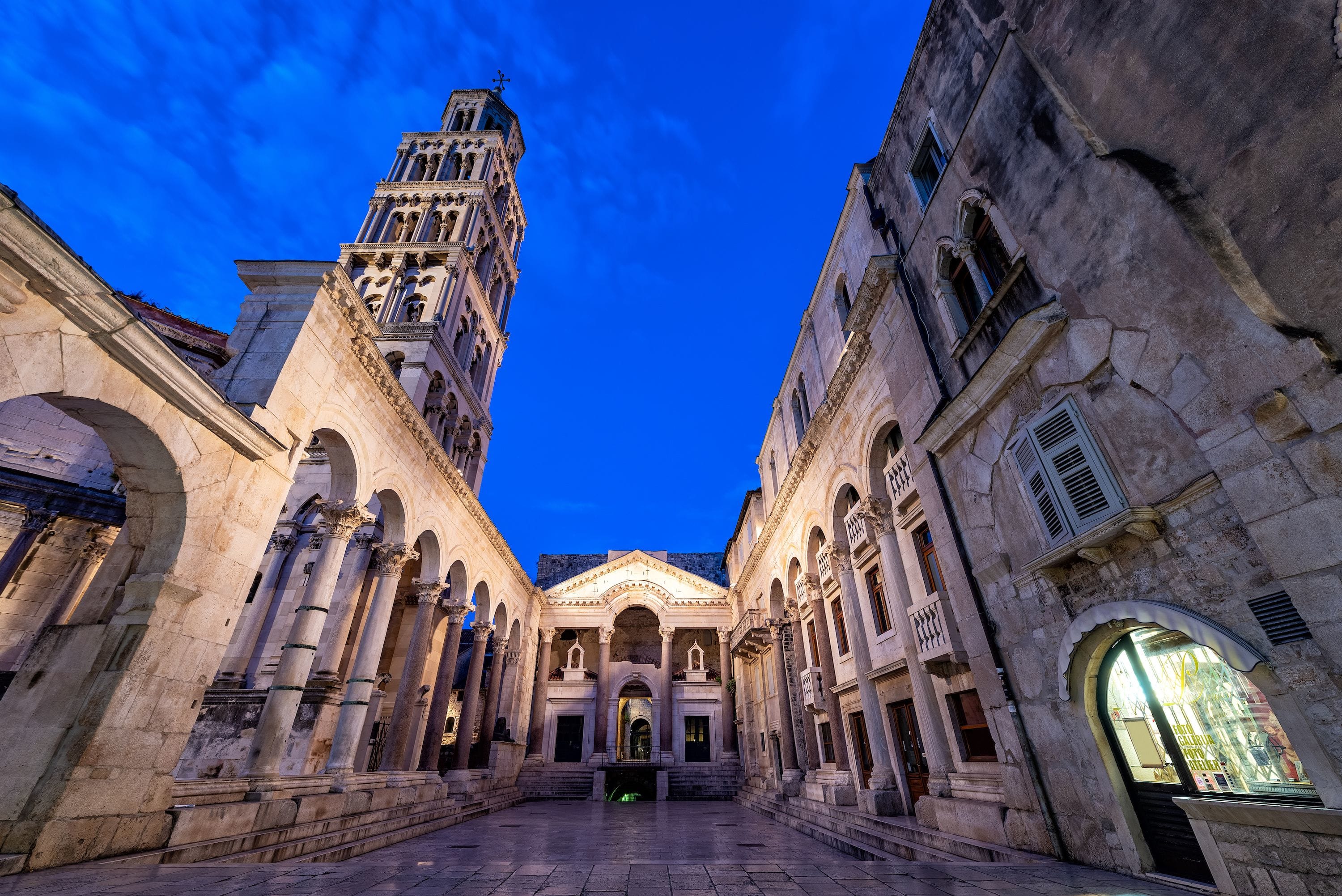
Peristyle
 Highlight of Split Old Town Walking Tour
Highlight of Split Old Town Walking TourSee the beautiful courtyard which was once the center of the palace, and is now the heart of Split.
The Peristyle was the central courtyard of the palace complex and the crossing point of its main streets. The columns around the courtyard were pillaged from Egypt, though the officer in charge of the operation must have forgotten to get some extras as four of the columns are clearly different from the others. There's also a black granite Egyptian sphinx on one side dating from 1500 BC which originally flanked the entrance to Diocletian's mausoleum (other sphinxes around the palace were decapitated by Diocletian to allay his superstition that they posed a threat to his rule). If you sit on one of the red cushions scattered around the Peristyle you'll be approached by a waiter with a menu of very expensive drinks, but it may be worth it just to sit and lap up the history and watch people go by. At the southern end of the Peristyle, steps lead up to a cone-shaped, roofless chamber which once served as the palace vestibule. Visitors would wait here before being summoned before the ex-emperor into his private apartments.
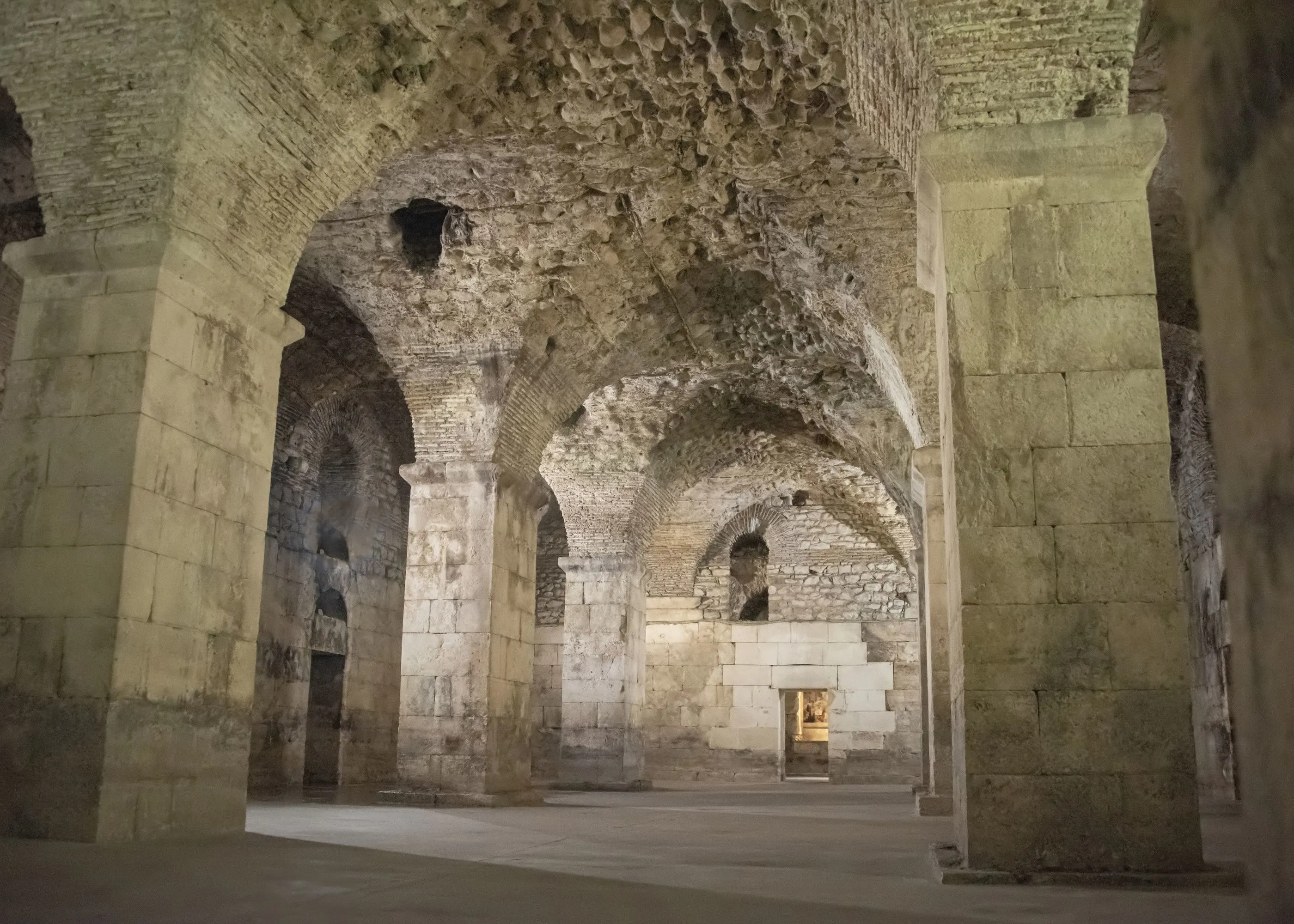
Bronze Gate and Palace Cellars
 Highlight of Split Old Town Walking Tour
Highlight of Split Old Town Walking TourEnter this ancient gateway to discover palace cellars used as film sets for Game of Thrones.
While today about 200 feet (60m) from the water, the Bronze Gate originally sat directly on the sea, allowing boats to pull directly up to the palace. As you enter the gate you will find a mass of souvenir and arts & crafts stalls, but just inside the entrance on either side are the substructures, or cellars of the palace. After the palace fell into disrepair, the cellars were used as rubbish pits. Families occupying the apartments above would simply create holes in the floor and voila, they had an instant trash dump with a seemingly unending supply of space. Of course centuries of trash did eventually them fill up and they were only rediscovered in 1956; the excavations continue to this very day. While entrance to the cellar is not free, it provides an excellent idea of what the palace must originally have looked like, as they're an exact mirror image of the imperial living quarters above. Game of Thrones fans will also be happy to learn that the cellar was used as a filming set, including as Daenerys Targaryen's grand Meereen throne room.

Peristyle
 Highlight of Split Old Town Walking Tour
Highlight of Split Old Town Walking TourSee the beautiful courtyard which was once the center of the palace, and is now the heart of Split.
The Peristyle was the central courtyard of the palace complex and the crossing point of its main streets. The columns around the courtyard were pillaged from Egypt, though the officer in charge of the operation must have forgotten to get some extras as four of the columns are clearly different from the others. There's also a black granite Egyptian sphinx on one side dating from 1500 BC which originally flanked the entrance to Diocletian's mausoleum (other sphinxes around the palace were decapitated by Diocletian to allay his superstition that they posed a threat to his rule). If you sit on one of the red cushions scattered around the Peristyle you'll be approached by a waiter with a menu of very expensive drinks, but it may be worth it just to sit and lap up the history and watch people go by. At the southern end of the Peristyle, steps lead up to a cone-shaped, roofless chamber which once served as the palace vestibule. Visitors would wait here before being summoned before the ex-emperor into his private apartments.

Bronze Gate and Palace Cellars
 Highlight of Split Old Town Walking Tour
Highlight of Split Old Town Walking TourEnter this ancient gateway to discover palace cellars used as film sets for Game of Thrones.
While today about 200 feet (60m) from the water, the Bronze Gate originally sat directly on the sea, allowing boats to pull directly up to the palace. As you enter the gate you will find a mass of souvenir and arts & crafts stalls, but just inside the entrance on either side are the substructures, or cellars of the palace. After the palace fell into disrepair, the cellars were used as rubbish pits. Families occupying the apartments above would simply create holes in the floor and voila, they had an instant trash dump with a seemingly unending supply of space. Of course centuries of trash did eventually them fill up and they were only rediscovered in 1956; the excavations continue to this very day. While entrance to the cellar is not free, it provides an excellent idea of what the palace must originally have looked like, as they're an exact mirror image of the imperial living quarters above. Game of Thrones fans will also be happy to learn that the cellar was used as a filming set, including as Daenerys Targaryen's grand Meereen throne room.

Peristyle
 Highlight of Split Old Town Walking Tour
Highlight of Split Old Town Walking TourSee the beautiful courtyard which was once the center of the palace, and is now the heart of Split.
The Peristyle was the central courtyard of the palace complex and the crossing point of its main streets. The columns around the courtyard were pillaged from Egypt, though the officer in charge of the operation must have forgotten to get some extras as four of the columns are clearly different from the others. There's also a black granite Egyptian sphinx on one side dating from 1500 BC which originally flanked the entrance to Diocletian's mausoleum (other sphinxes around the palace were decapitated by Diocletian to allay his superstition that they posed a threat to his rule). If you sit on one of the red cushions scattered around the Peristyle you'll be approached by a waiter with a menu of very expensive drinks, but it may be worth it just to sit and lap up the history and watch people go by. At the southern end of the Peristyle, steps lead up to a cone-shaped, roofless chamber which once served as the palace vestibule. Visitors would wait here before being summoned before the ex-emperor into his private apartments.

Bronze Gate and Palace Cellars
 Highlight of Split Old Town Walking Tour
Highlight of Split Old Town Walking TourEnter this ancient gateway to discover palace cellars used as film sets for Game of Thrones.
While today about 200 feet (60m) from the water, the Bronze Gate originally sat directly on the sea, allowing boats to pull directly up to the palace. As you enter the gate you will find a mass of souvenir and arts & crafts stalls, but just inside the entrance on either side are the substructures, or cellars of the palace. After the palace fell into disrepair, the cellars were used as rubbish pits. Families occupying the apartments above would simply create holes in the floor and voila, they had an instant trash dump with a seemingly unending supply of space. Of course centuries of trash did eventually them fill up and they were only rediscovered in 1956; the excavations continue to this very day. While entrance to the cellar is not free, it provides an excellent idea of what the palace must originally have looked like, as they're an exact mirror image of the imperial living quarters above. Game of Thrones fans will also be happy to learn that the cellar was used as a filming set, including as Daenerys Targaryen's grand Meereen throne room.
prev
next


Day 3
Split
Day 3
Split

Early Morning to Afternoon
Excursion to the Idyllic Brač Island
The third-largest of Croatia's islands, Brač is also the nearest major island to Split and therefore the easiest to get to with ferries running regular 50-minute trips to Supetar, an attractive former fishing village with shallow and swimmable pebbly beaches. On the opposite side of the island is the similarly picturesque village of Bol, boasting the magnificent beach of Zlatni Rat, pictures of which adorn just about every advertising brochure there is on Dalmatia's islands. Zlatni Rat has a mild-breezy climate that makes it perfect for windsurfing. Bol is accessible from Supetar by public bus, but to get around the island to see smaller coastal settlements like Postira, Pučišća, Povlja, and Milna, and the highest peak of Vidova Gora, it's best to take a guided tour, hire a taxi, or rent a car. Renting a bicycle is also a great option for exploring the island. This will also give you the chance to explore the island's beautiful interior, with its scrub-covered rocky uplands interspersed with fertile valleys, where you'll find vineyards, olive groves, and orange trees. You'll also see the great man-made piles of limestone built up over centuries by small farmers clearing a place to grow their crops. Just keep in mind that if you visit Brač in the off season, it will be very sleepy. This is great if you like to explore without crowds, but not so great if you mind closed restaurants and attractions.

Zlatni Rat
Take a swim in one of Croatia's most famous and beautiful beaches.
Show More

Dominican Monastery of Bol
Explore the picturesque town of Bol and take a quick walk to the Dominican monastery.
Show More

Pučišća
Visit this seaside hamlet recently rated as one of the top ten most picturesque villages in all of Europe.
Show More

Škrip
Discover the oldest continually inhabited settlement on the island.
Show More

Zlatni Rat
Take a swim in one of Croatia's most famous and beautiful beaches.
Show More

Dominican Monastery of Bol
Explore the picturesque town of Bol and take a quick walk to the Dominican monastery.
Show More

Pučišća
Visit this seaside hamlet recently rated as one of the top ten most picturesque villages in all of Europe.
Show More

Škrip
Discover the oldest continually inhabited settlement on the island.
Show More
prev
next

Day 3
Split

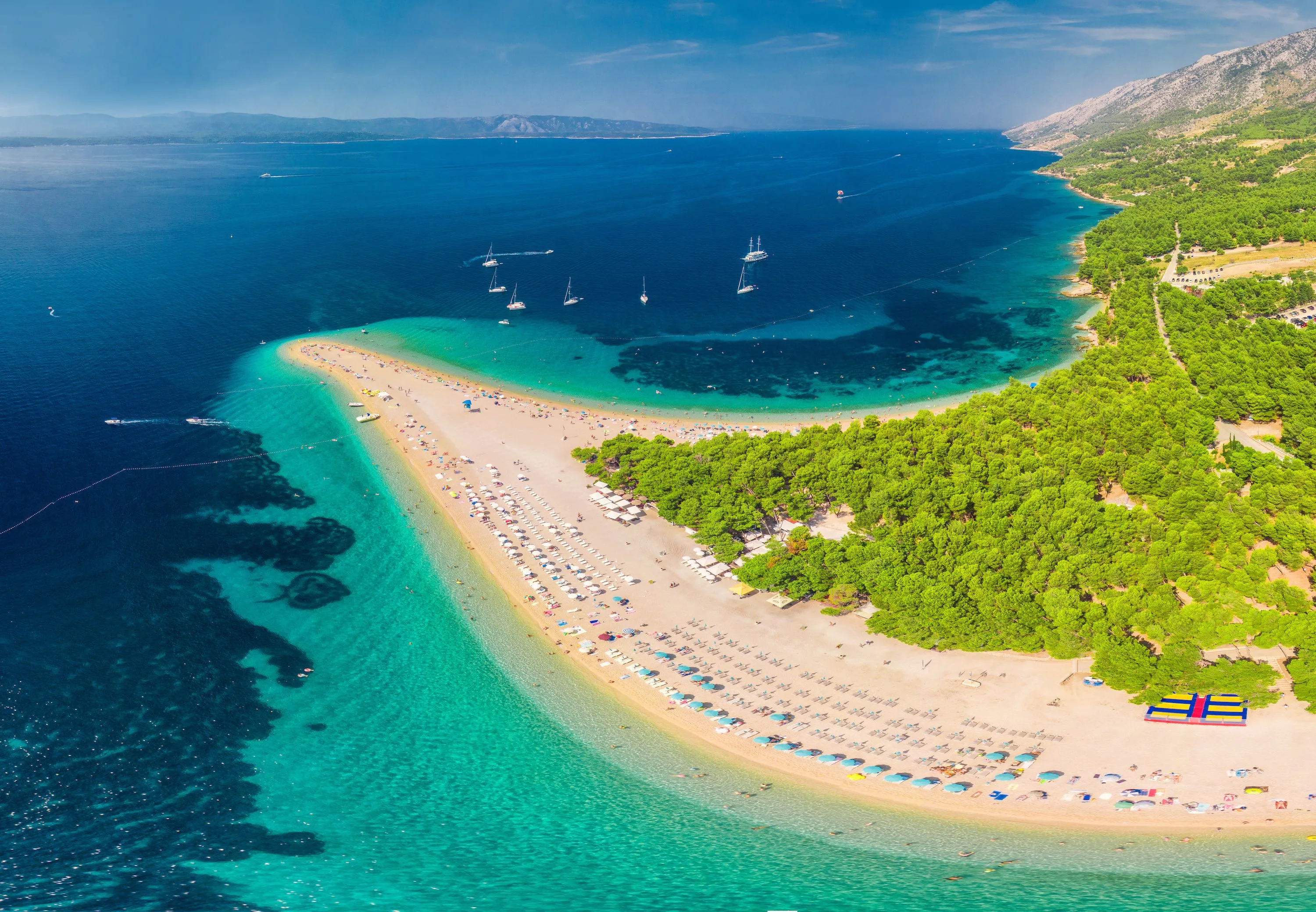
Zlatni Rat
 Highlight of Brač Island
Highlight of Brač IslandTake a swim in one of Croatia's most famous and beautiful beaches.
Zlatni Rat (Golden Cape) is a beautiful tongue of white pebble beach jutting into the sea, and is one of the most popular swimming and sunbathing spots in Croatia. Its summer breezes also make it a favorite among wind surfers. Huge crowds flock to it in the summer months, so it is not ideal for those looking for an isolated spot to themselves. You can easily reach the beach from the town of Bol, as it is only a 20 minute walk along a tree-lined promenade. In high season you'll find all manner of diversions here, including food options, bicycles for hire, scooters and quad bikes, boat rentals, windsurfing, water taxis to more isolated coves and beaches, and snorkeling and scuba diving courses.
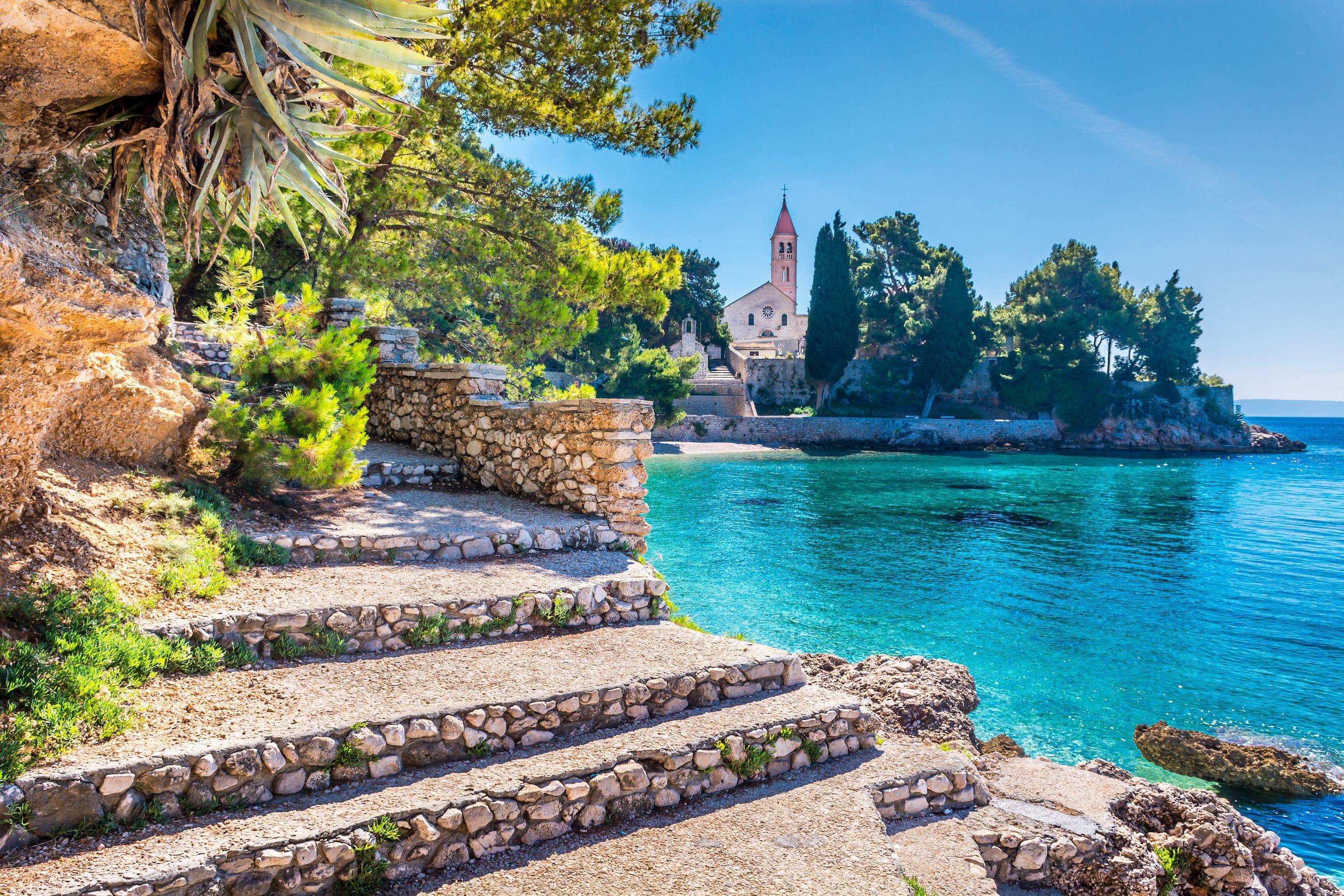
Dominican Monastery of Bol
 Highlight of Brač Island
Highlight of Brač IslandExplore the picturesque town of Bol and take a quick walk to the Dominican monastery.
Bol's setting is indeed quite beautiful, hugging the coastal flanks of Brac's tallest mountain, but it attracts huge crowds in the summer months that flock to the nearby beautiful beach of Zlatni Rat (Golden Cape). The town of Bol itself is thankfully free of high rise package hotels and somehow manages to retain some modesty and charm around its attractive harbor. Take time to pop up to the Dominican monastery which is dramatically located high on an outcrop just east of Bol's center - the assiduously maintained monastery gardens overlooking the sea are worth the walk up.

Pučišća
 Highlight of Brač Island
Highlight of Brač IslandVisit this seaside hamlet recently rated as one of the top ten most picturesque villages in all of Europe.
The stone-quarrying village of Pučišća is hidden in the western arm of a long Y-shaped inlet and is assembled around a rough-hewn pair of medieval defensive towers and a gnarled church belfry. The harbor is clean enough to swim in and there are pleasant rocky beaches on the northwestern side of the inlet. There's a stone-carving school in the village and white-stone souvenirs are the stock-in-trade here.

Škrip
 Highlight of Brač Island
Highlight of Brač IslandDiscover the oldest continually inhabited settlement on the island.
Located on the interior of the island, Škrip has an entirely different atmosphere from the ritzy beach towns. Indeed, it's a sleepy nest of stone houses with heavy stone roof-tiles and feels a bit lost in time - in a good way. You'll also find 16th-century castle ruins and the island's museum at its eastern end. The museum contains a well-preserved Roman relief of Hercules and miscellaneous 19th-century agricultural tools. There's a Roman mausoleum outside that allegedly contains the wife or daughter of Diocletian. At the top of the village you'll find an ancient church and graveyard from where you'll enjoy a wonderful view of the countryside.

Zlatni Rat
 Highlight of Brač Island
Highlight of Brač IslandTake a swim in one of Croatia's most famous and beautiful beaches.
Zlatni Rat (Golden Cape) is a beautiful tongue of white pebble beach jutting into the sea, and is one of the most popular swimming and sunbathing spots in Croatia. Its summer breezes also make it a favorite among wind surfers. Huge crowds flock to it in the summer months, so it is not ideal for those looking for an isolated spot to themselves. You can easily reach the beach from the town of Bol, as it is only a 20 minute walk along a tree-lined promenade. In high season you'll find all manner of diversions here, including food options, bicycles for hire, scooters and quad bikes, boat rentals, windsurfing, water taxis to more isolated coves and beaches, and snorkeling and scuba diving courses.

Dominican Monastery of Bol
 Highlight of Brač Island
Highlight of Brač IslandExplore the picturesque town of Bol and take a quick walk to the Dominican monastery.
Bol's setting is indeed quite beautiful, hugging the coastal flanks of Brac's tallest mountain, but it attracts huge crowds in the summer months that flock to the nearby beautiful beach of Zlatni Rat (Golden Cape). The town of Bol itself is thankfully free of high rise package hotels and somehow manages to retain some modesty and charm around its attractive harbor. Take time to pop up to the Dominican monastery which is dramatically located high on an outcrop just east of Bol's center - the assiduously maintained monastery gardens overlooking the sea are worth the walk up.

Pučišća
 Highlight of Brač Island
Highlight of Brač IslandVisit this seaside hamlet recently rated as one of the top ten most picturesque villages in all of Europe.
The stone-quarrying village of Pučišća is hidden in the western arm of a long Y-shaped inlet and is assembled around a rough-hewn pair of medieval defensive towers and a gnarled church belfry. The harbor is clean enough to swim in and there are pleasant rocky beaches on the northwestern side of the inlet. There's a stone-carving school in the village and white-stone souvenirs are the stock-in-trade here.

Škrip
 Highlight of Brač Island
Highlight of Brač IslandDiscover the oldest continually inhabited settlement on the island.
Located on the interior of the island, Škrip has an entirely different atmosphere from the ritzy beach towns. Indeed, it's a sleepy nest of stone houses with heavy stone roof-tiles and feels a bit lost in time - in a good way. You'll also find 16th-century castle ruins and the island's museum at its eastern end. The museum contains a well-preserved Roman relief of Hercules and miscellaneous 19th-century agricultural tools. There's a Roman mausoleum outside that allegedly contains the wife or daughter of Diocletian. At the top of the village you'll find an ancient church and graveyard from where you'll enjoy a wonderful view of the countryside.
prev
next


Day 4
Split to Zagreb
Day 4
Split to Zagreb





7:50 AM
Transfer to Rail Station by Taxi or Walking
First keep in mind that the rail station is located only about a 1/2-mile (800m) from the Split Old Town. Also consider that if staying in the pedestrian area of Old Town, a car cannot pick you up directly from the hotel, meaning you will have to walk a short distance with your bags anyway. If this is an issue, be sure to arrange assistance with a private transfer service or with your hotel beforehand. UberX is available in Split if you prefer to take a car. If staying in a hotel, they can also arrange a taxi pick up for you. The price should be about 50-100 HRK depending on your hotel location. For the most convenience, you can arrange a private transfer to the rail station. Although antiquated, the Split train station is pleasantly small in comparison with other European cities. You will be dropped off directly in front of the main station building on the waterfront where the main bus station and the ferry terminal are also located. This makes it slightly chaotic when a lot of buses arrive at the same time, but it is much less busy inside the train station where you'll find a number of electronic screens displaying arrival and departure times and platform numbers in both Croat and English. You'll find the train platforms lined up directly out the back of the station hall.

Day 4
Split to Zagreb



Day 5
Zagreb to Budapest
Day 5
Zagreb to Budapest





9:00 AM - 11:30 AM
Highlights of Zagreb, Guided Tour
On this 2.5-hour private tour, you will see the main sights and vibrant everyday life in Zagreb. You will visit the oldest parts of town, hear genuine Zagreb stories and legends, and enjoy a walk through the old town's green promenade. Highlights include Zagreb cathedral, the short funicular connecting the lower and uppers parts of the city, the oldest part of the city called Gradec were the city's parliament and best museums are to be found, the famous pedestrianized Tkalčićeva Street that has one of the most engaging and fun dining areas in Southern Europe and the open-air market of Dolac.

Museum of Broken Relationships
Enjoy an intriguing and bitter-sweet visit to a unique museum focused on heartbreak.
Show More

St Mark's Church and Square
Be sure to stop by the picturesque square and church at the heart of Old Zagreb.
Show More

Lotrščak Tower
Historic lookout tower
Show More

Museum of Broken Relationships
Enjoy an intriguing and bitter-sweet visit to a unique museum focused on heartbreak.
Show More

St Mark's Church and Square
Be sure to stop by the picturesque square and church at the heart of Old Zagreb.
Show More

Lotrščak Tower
Historic lookout tower
Show More

Museum of Broken Relationships
Enjoy an intriguing and bitter-sweet visit to a unique museum focused on heartbreak.
Show More
prev
next

Day 5
Zagreb to Budapest

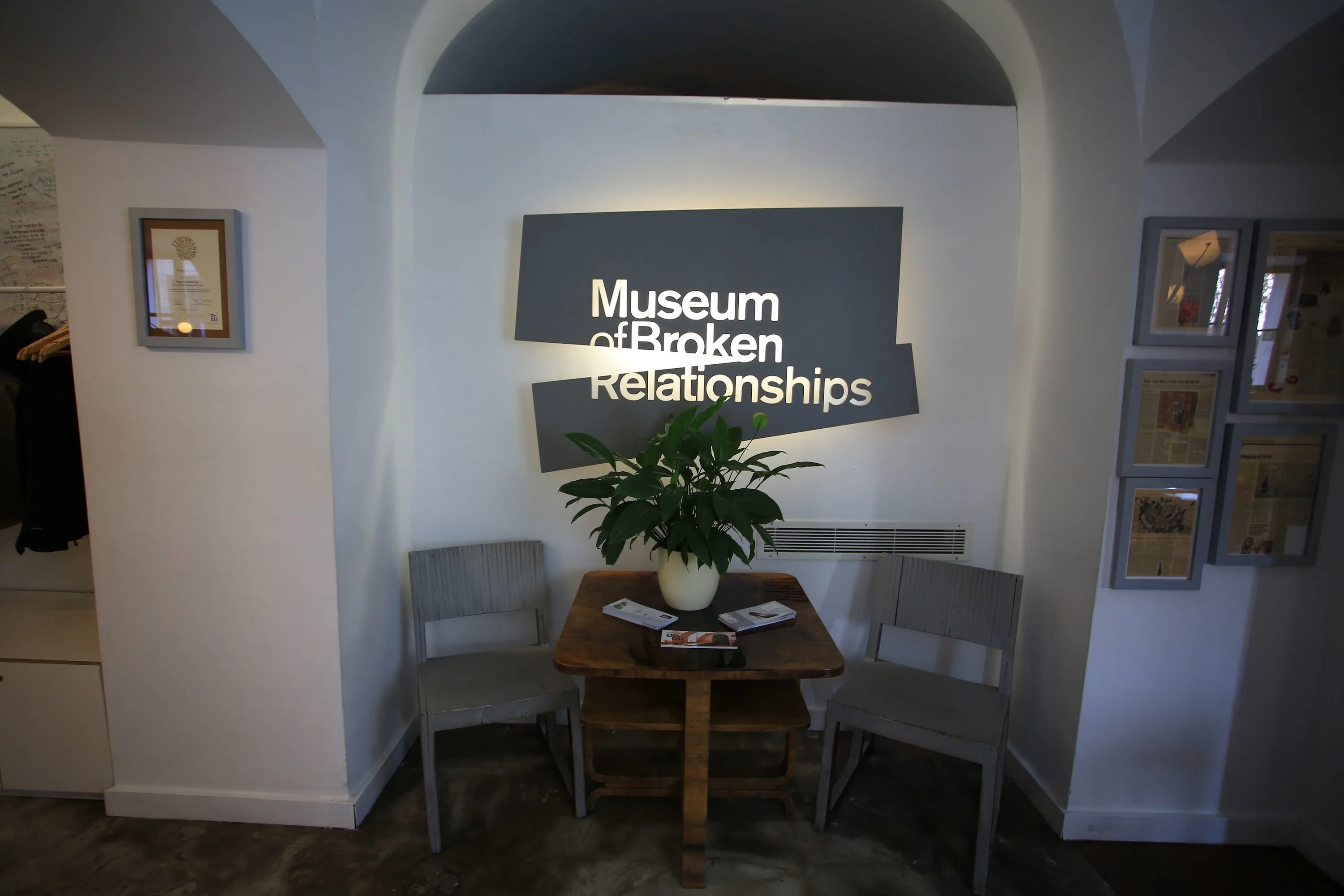
Museum of Broken Relationships
 Highlight of Highlights of Zagreb, Guided Tour
Highlight of Highlights of Zagreb, Guided TourEnjoy an intriguing and bitter-sweet visit to a unique museum focused on heartbreak.
One of Zagreb's most quirky museums is the Museum of Broken Relationships. At first a temporary exhibition only, it struck such a chord with the public that it became a permanent museum in 2010, displaying objects connected with all aspects of human relationships and break-ups. A compelling and sometimes visceral monument to wistful memory and raw emotion, visitors are invited to overcome a difficult separation by donating memories and thus recognizing the end of a relationship.
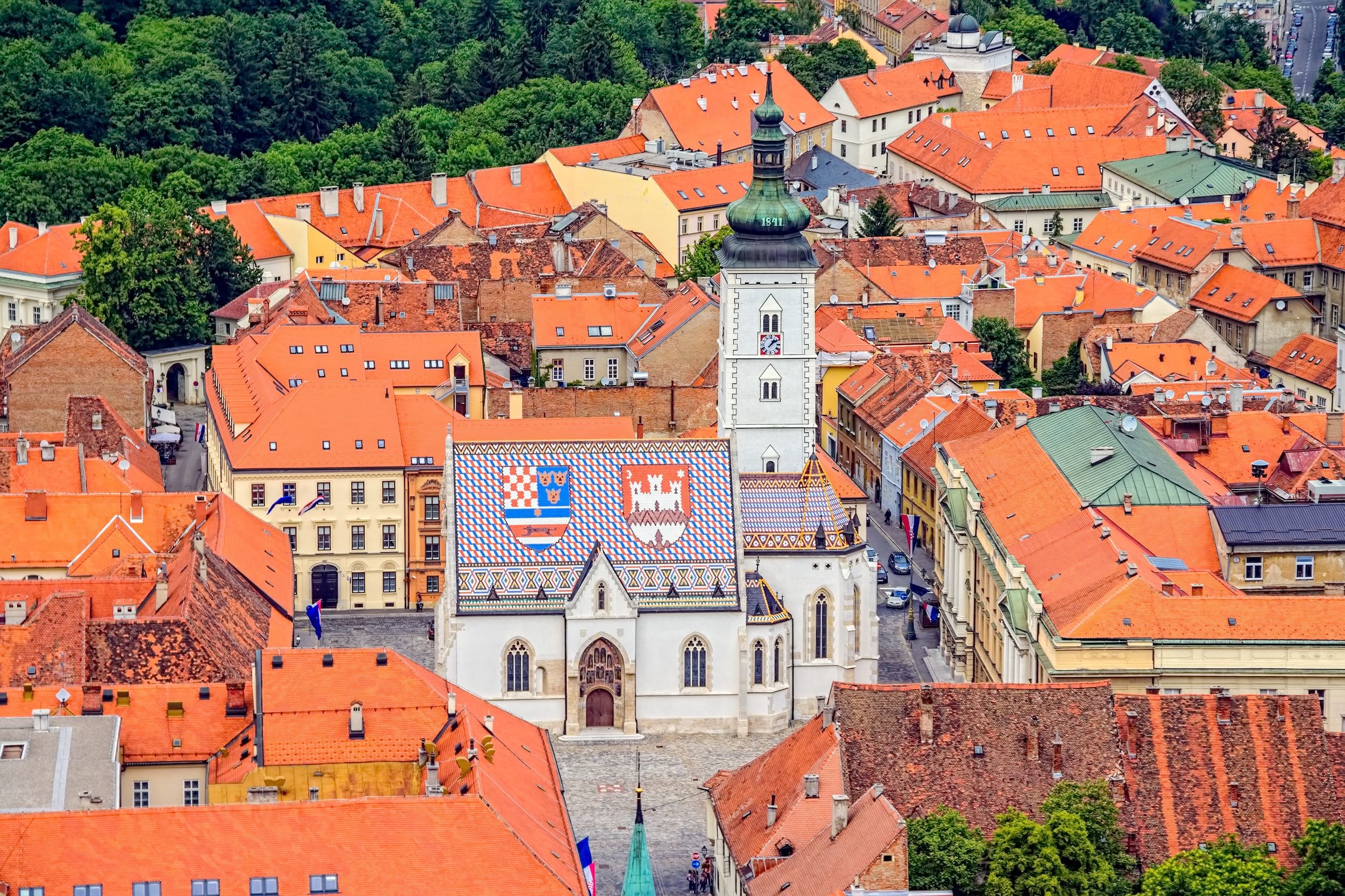
St Mark's Church and Square
 Highlight of Highlights of Zagreb, Guided Tour
Highlight of Highlights of Zagreb, Guided TourBe sure to stop by the picturesque square and church at the heart of Old Zagreb.
Markov trg at the center of Gradec hosts the surprisingly modest Sabor or national parliament and the rather squat but nonetheless attractive St Mark's Church, with its famously multi-colored roof tiles displaying the coat of arms of Zagreb and Croatia. The interior has been ravaged over time by earthquake, fire, and 19th-century "restorers", but some parts, like the south portal, are original. The building on the other side is the Banski dvor, or Ban's Palace, originally the seat of the Hapsburg-appointed governor and now the seat of Croatia's government.
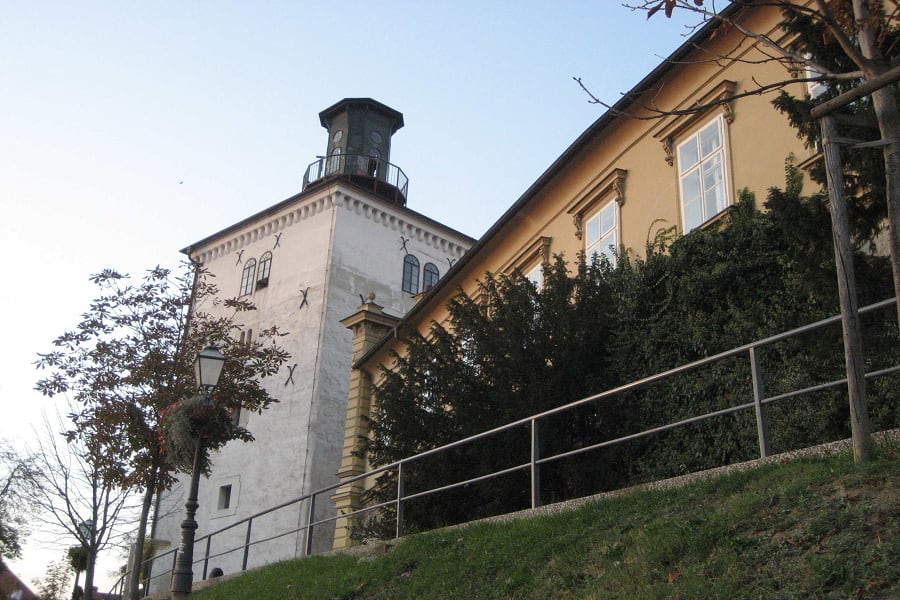
Lotrščak Tower
 Highlight of Highlights of Zagreb, Guided Tour
Highlight of Highlights of Zagreb, Guided TourHistoric lookout tower
A tower that once protected the southern city gate from danger. A spiral staircase inside leads to a small wooden terrace offering superb views of Zagreb's roofscape.

Museum of Broken Relationships
 Highlight of Highlights of Zagreb, Guided Tour
Highlight of Highlights of Zagreb, Guided TourEnjoy an intriguing and bitter-sweet visit to a unique museum focused on heartbreak.
One of Zagreb's most quirky museums is the Museum of Broken Relationships. At first a temporary exhibition only, it struck such a chord with the public that it became a permanent museum in 2010, displaying objects connected with all aspects of human relationships and break-ups. A compelling and sometimes visceral monument to wistful memory and raw emotion, visitors are invited to overcome a difficult separation by donating memories and thus recognizing the end of a relationship.

St Mark's Church and Square
 Highlight of Highlights of Zagreb, Guided Tour
Highlight of Highlights of Zagreb, Guided TourBe sure to stop by the picturesque square and church at the heart of Old Zagreb.
Markov trg at the center of Gradec hosts the surprisingly modest Sabor or national parliament and the rather squat but nonetheless attractive St Mark's Church, with its famously multi-colored roof tiles displaying the coat of arms of Zagreb and Croatia. The interior has been ravaged over time by earthquake, fire, and 19th-century "restorers", but some parts, like the south portal, are original. The building on the other side is the Banski dvor, or Ban's Palace, originally the seat of the Hapsburg-appointed governor and now the seat of Croatia's government.

Lotrščak Tower
 Highlight of Highlights of Zagreb, Guided Tour
Highlight of Highlights of Zagreb, Guided TourHistoric lookout tower
A tower that once protected the southern city gate from danger. A spiral staircase inside leads to a small wooden terrace offering superb views of Zagreb's roofscape.

Museum of Broken Relationships
 Highlight of Highlights of Zagreb, Guided Tour
Highlight of Highlights of Zagreb, Guided TourEnjoy an intriguing and bitter-sweet visit to a unique museum focused on heartbreak.
One of Zagreb's most quirky museums is the Museum of Broken Relationships. At first a temporary exhibition only, it struck such a chord with the public that it became a permanent museum in 2010, displaying objects connected with all aspects of human relationships and break-ups. A compelling and sometimes visceral monument to wistful memory and raw emotion, visitors are invited to overcome a difficult separation by donating memories and thus recognizing the end of a relationship.
prev
next

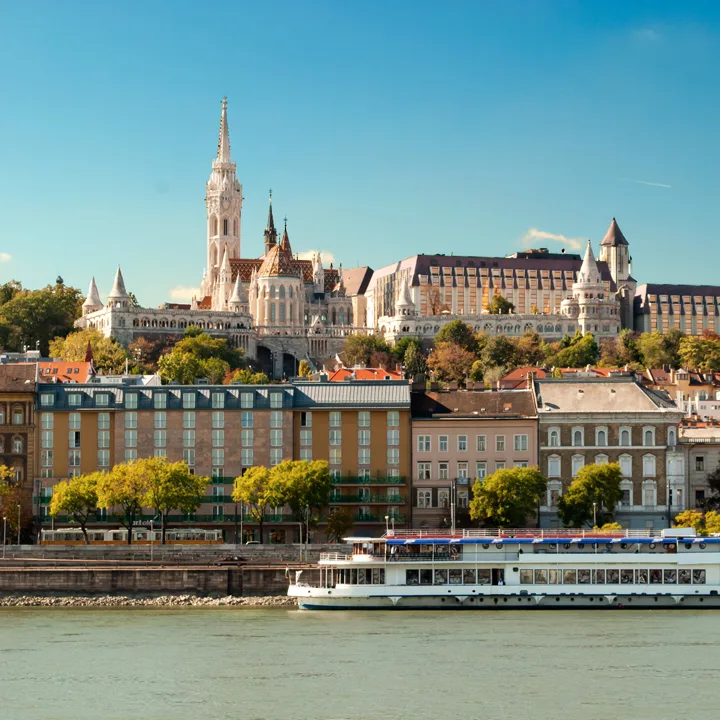
Day 6
Budapest
Day 6
Budapest



9:30 AM - 1:00 PM
Best of Budapest: Half-Day Walking Tour of Highlights & Hidden Finds
During your tour you will take in a gorgeous vista of the city from the Fisherman's Bastion, explore the winding streets of the Castle District, gaze in awe at the striking interior of St. Stephen's Basilica, travel along the city's most elegant avenue and more. Along the way you will experience the city as a local does, stopping to check out intimate courtyards, enjoying a pastry and soaking in the ambiance of Budapest's most elegant cafes.

Day 6
Budapest



Day 7
Budapest to Prague
Day 7
Budapest to Prague





Early Morning/Morning
Exploring Central Pest
In Central Pest you will discover the beating heart of the city, with grand apartment houses and art nouveau architectural gems. No visit to Budapest is complete without seeing its highlights, including St. Stephen's Basilica, which dramatically rises above the city, and the Chain Bridge, which regally spans the Danube.

Café Gerbeaud
Enjoy a leisurely coffee and cake in one of Budapest's most storied cafes.
Show More

Gresham Palace
Take a peak at this pearl of art nouveau architecture, which now houses a Four Seasons Hotel.
Show More

St. Stephen's Basilica
Enjoy an awe-inspiring visit to this vast cupola-topped church; the most famous in Budapest.
Show More

Széchenyi Chain Bridge
Stroll across a beautiful landmark 19th-century suspension bridge which is a symbol of Budapest.
Show More

Café Gerbeaud
Enjoy a leisurely coffee and cake in one of Budapest's most storied cafes.
Show More

Gresham Palace
Take a peak at this pearl of art nouveau architecture, which now houses a Four Seasons Hotel.
Show More

St. Stephen's Basilica
Enjoy an awe-inspiring visit to this vast cupola-topped church; the most famous in Budapest.
Show More

Széchenyi Chain Bridge
Stroll across a beautiful landmark 19th-century suspension bridge which is a symbol of Budapest.
Show More
prev
next

Day 7
Budapest to Prague

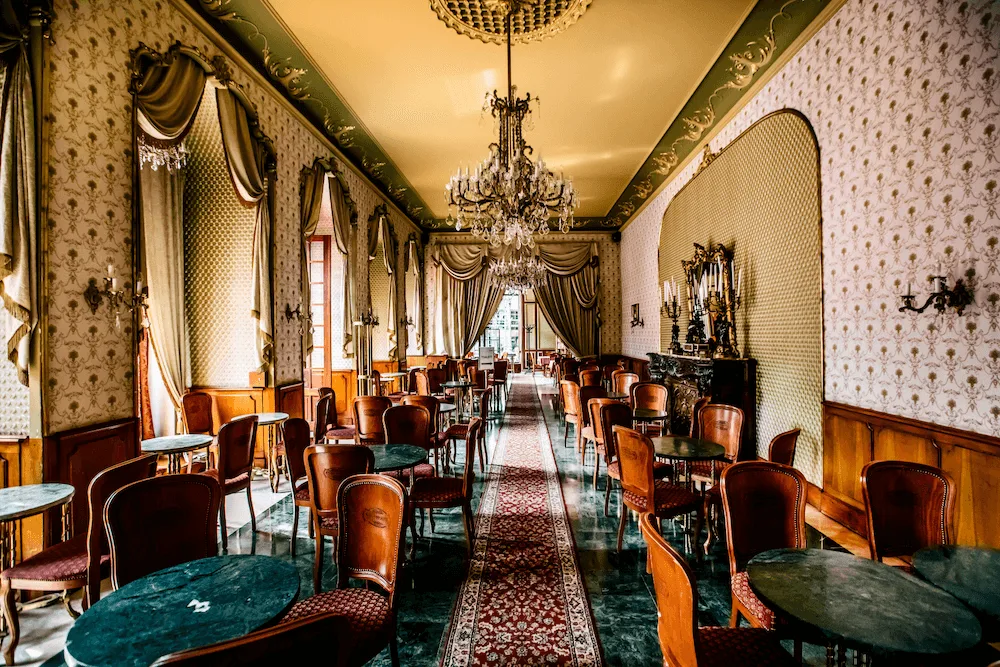
Café Gerbeaud
 Highlight of Central Pest
Highlight of Central PestEnjoy a leisurely coffee and cake in one of Budapest's most storied cafes.
Over 160 years old, with a grand, high-ceilinged dining room, the cafe is deservedly one of Budapest's most popular attractions. It serves coffee, mouthwatering Hungarian pastries, and traditional bistro dishes. It retains the elegance and sophistication of its 19th century origins, and the terrace sits on the lively Vörösmarty Square.
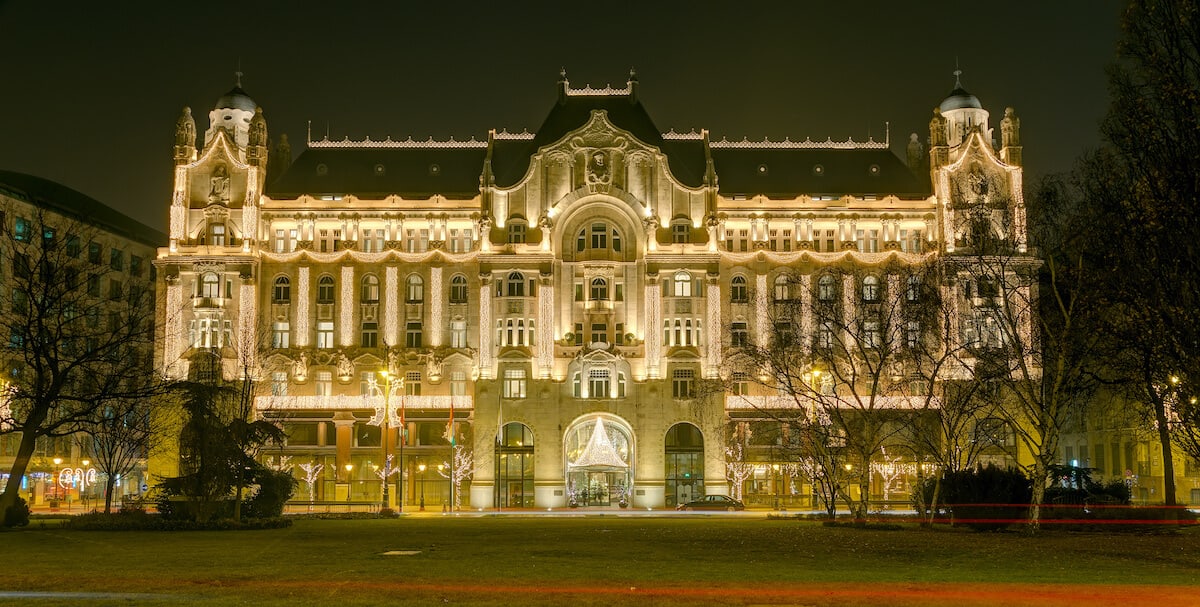
Gresham Palace
 Highlight of Central Pest
Highlight of Central PestTake a peak at this pearl of art nouveau architecture, which now houses a Four Seasons Hotel.
The hotel doesn't mind tourists exploring the lavish arcade on the first floor, as it is lined by shops and a café. Be sure to note the organic themes of the façade and the beautiful wrought iron peacock gate on the north side of the building.

St. Stephen's Basilica
 Highlight of Central Pest
Highlight of Central PestEnjoy an awe-inspiring visit to this vast cupola-topped church; the most famous in Budapest.
Completed in 1905, the construction of the neo-classical Catholic church took over 50 years. The mummified hand of Hungary's first king, St. Stephen, is kept in a small chapel in the rear. Take a lift to the dome to enjoy one of Budapest's most interesting panoramic views. The church hosts frequent concerts.
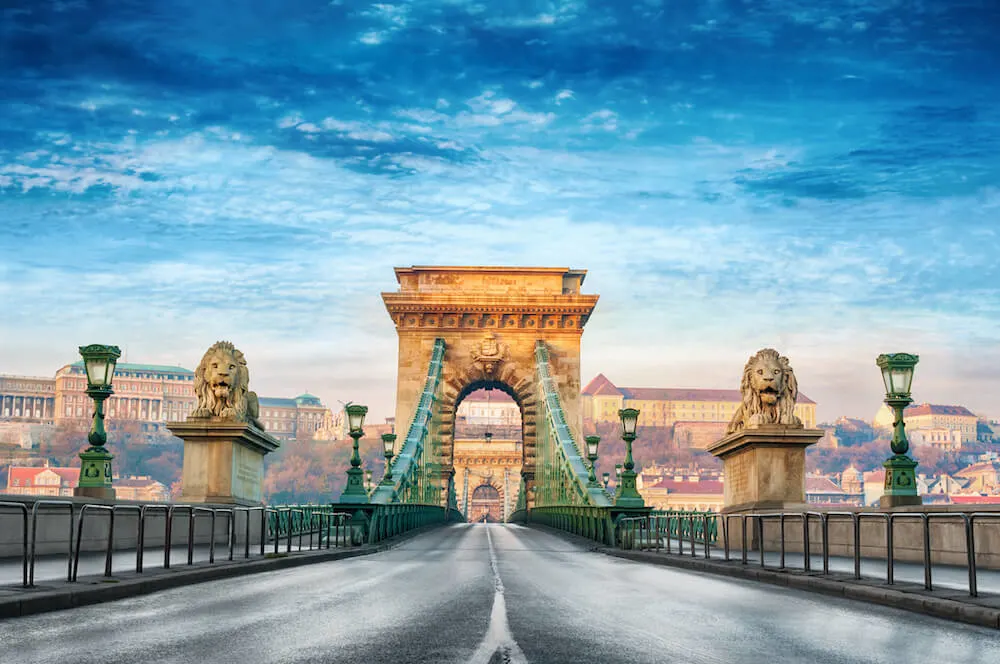
Széchenyi Chain Bridge
 Highlight of Central Pest
Highlight of Central PestStroll across a beautiful landmark 19th-century suspension bridge which is a symbol of Budapest.
This was Budapest's first permanent bridge over the Danube, enabling the cities of Buda and Pest to merge. Named after Count István Széchenyi, it hangs from iron chains (hence, the Chain Bridge) anchored by two towering river piers. These piers were the only elements to survive WWII fighting. The rest was rebuilt.

Café Gerbeaud
 Highlight of Central Pest
Highlight of Central PestEnjoy a leisurely coffee and cake in one of Budapest's most storied cafes.
Over 160 years old, with a grand, high-ceilinged dining room, the cafe is deservedly one of Budapest's most popular attractions. It serves coffee, mouthwatering Hungarian pastries, and traditional bistro dishes. It retains the elegance and sophistication of its 19th century origins, and the terrace sits on the lively Vörösmarty Square.

Gresham Palace
 Highlight of Central Pest
Highlight of Central PestTake a peak at this pearl of art nouveau architecture, which now houses a Four Seasons Hotel.
The hotel doesn't mind tourists exploring the lavish arcade on the first floor, as it is lined by shops and a café. Be sure to note the organic themes of the façade and the beautiful wrought iron peacock gate on the north side of the building.

St. Stephen's Basilica
 Highlight of Central Pest
Highlight of Central PestEnjoy an awe-inspiring visit to this vast cupola-topped church; the most famous in Budapest.
Completed in 1905, the construction of the neo-classical Catholic church took over 50 years. The mummified hand of Hungary's first king, St. Stephen, is kept in a small chapel in the rear. Take a lift to the dome to enjoy one of Budapest's most interesting panoramic views. The church hosts frequent concerts.

Széchenyi Chain Bridge
 Highlight of Central Pest
Highlight of Central PestStroll across a beautiful landmark 19th-century suspension bridge which is a symbol of Budapest.
This was Budapest's first permanent bridge over the Danube, enabling the cities of Buda and Pest to merge. Named after Count István Széchenyi, it hangs from iron chains (hence, the Chain Bridge) anchored by two towering river piers. These piers were the only elements to survive WWII fighting. The rest was rebuilt.
prev
next


Day 8
Prague
Day 8
Prague



9:00 AM - 12:30 PM
Prague Castle & Royal Route Guided Walk
On this charming guided walk, you will explore the Prague Castle, the largest castle complex in all of Europe. To reach the castle you will trace the Royal Coronation Route and cross the Charles Bridge, whose “speaking stones” reveal the amazing and often cruel history that occurred there. Your tour guide will then take you either through the castle courtyards and into the dramatic St. Vitus Cathedral in the center of the castle complex, or through the upper part of the castle district around the oversized palaces of the old Catholic nobility and the top of the Castle Steps for incomparable views over the red rooftops of the Little Quarter.

Charles Bridge
Cross the river dividing Prague's most historic neighborhoods, and experience one of Europe's most iconic landmarks.
Show More

Maltese Square & Lennon Wall
See a historic wall that has been covered in John Lennon-inspired graffiti since Communist days.
Show More

Prague Castle
Prague Castle is one of the main attractions in Prague and is also the largest castle complex in the world.
Show More

Charles Bridge
Cross the river dividing Prague's most historic neighborhoods, and experience one of Europe's most iconic landmarks.
Show More

Maltese Square & Lennon Wall
See a historic wall that has been covered in John Lennon-inspired graffiti since Communist days.
Show More

Prague Castle
Prague Castle is one of the main attractions in Prague and is also the largest castle complex in the world.
Show More

Charles Bridge
Cross the river dividing Prague's most historic neighborhoods, and experience one of Europe's most iconic landmarks.
Show More
prev
next

Day 8
Prague

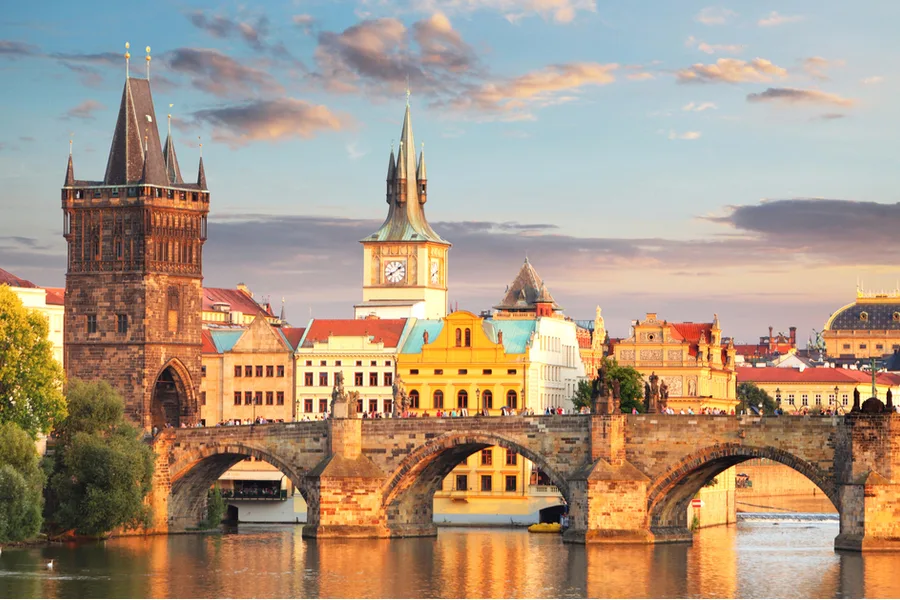
Charles Bridge
 Highlight of Royal Route Guided Tour
Highlight of Royal Route Guided TourCross the river dividing Prague's most historic neighborhoods, and experience one of Europe's most iconic landmarks.
Bridge construction began in 1357 under King Charles IV (hence the name), and it was the only bridge across the Vltava River until 1841. 30 baroque statues of saints line the bridge, and it is filled with street artists and entertainers. Not to be missed.

Maltese Square & Lennon Wall
 Highlight of Royal Route Guided Tour
Highlight of Royal Route Guided TourSee a historic wall that has been covered in John Lennon-inspired graffiti since Communist days.
The wall has been covered in graffiti since the 1960s, and during Communism anti-regime sentiment was common. John Lennon's assassination inspired grafitti reflecting his song, Imagine, which earned the wall its current moniker. It is now a favorite gathering place for tourists, and musicians sometimes congregate there as well. Just around the corner is the Maltese Square, which is one of Prague's more quaint and relaxed public spaces, despite being just off the main tourist route.

Prague Castle
 Highlight of Royal Route Guided Tour
Highlight of Royal Route Guided TourPrague Castle is one of the main attractions in Prague and is also the largest castle complex in the world.
The Prague Castle is the largest castle complex in the world with structures dating back to the 9th century. The St Vitus Cathedral and Basilica of St George can be found within the castle walls. The Prague Castle also includes several gardens, palaces, and a monastery. This castle was the seat of power for the Kings of Bohemia, Holy Roman Emperors, and presidents of former Czechoslovakia. Prague Castle is a UNESCO world heritage site and is one of the most visited places in the country.

Charles Bridge
 Highlight of Royal Route Guided Tour
Highlight of Royal Route Guided TourCross the river dividing Prague's most historic neighborhoods, and experience one of Europe's most iconic landmarks.
Bridge construction began in 1357 under King Charles IV (hence the name), and it was the only bridge across the Vltava River until 1841. 30 baroque statues of saints line the bridge, and it is filled with street artists and entertainers. Not to be missed.

Maltese Square & Lennon Wall
 Highlight of Royal Route Guided Tour
Highlight of Royal Route Guided TourSee a historic wall that has been covered in John Lennon-inspired graffiti since Communist days.
The wall has been covered in graffiti since the 1960s, and during Communism anti-regime sentiment was common. John Lennon's assassination inspired grafitti reflecting his song, Imagine, which earned the wall its current moniker. It is now a favorite gathering place for tourists, and musicians sometimes congregate there as well. Just around the corner is the Maltese Square, which is one of Prague's more quaint and relaxed public spaces, despite being just off the main tourist route.

Prague Castle
 Highlight of Royal Route Guided Tour
Highlight of Royal Route Guided TourPrague Castle is one of the main attractions in Prague and is also the largest castle complex in the world.
The Prague Castle is the largest castle complex in the world with structures dating back to the 9th century. The St Vitus Cathedral and Basilica of St George can be found within the castle walls. The Prague Castle also includes several gardens, palaces, and a monastery. This castle was the seat of power for the Kings of Bohemia, Holy Roman Emperors, and presidents of former Czechoslovakia. Prague Castle is a UNESCO world heritage site and is one of the most visited places in the country.

Charles Bridge
 Highlight of Royal Route Guided Tour
Highlight of Royal Route Guided TourCross the river dividing Prague's most historic neighborhoods, and experience one of Europe's most iconic landmarks.
Bridge construction began in 1357 under King Charles IV (hence the name), and it was the only bridge across the Vltava River until 1841. 30 baroque statues of saints line the bridge, and it is filled with street artists and entertainers. Not to be missed.
prev
next


Day 9
Prague
Day 9
Prague


Early Morning to Afternoon
Excursion to Medieval Kutna Hora and the Bone Church
On this full day self-guided excursion you will discover the charming Bohemian town of Kutná Hora. An hour-long train ride will take you through the attractive countryside, and then you will begin exploring the medieval town. Due to its silver mines, Kutná Hora was rich and powerful during the Middle Ages. It was even declared a Royal town, meaning that the Bohemian King directly controlled the town. The town spent much of its wealth on beautiful buildings, many of which still exist today, and which have earned the town the status of a UNESCO World Cultural site. Your visit may include stops at the incredible Gothic church of St. Barbara, the Royal Mint, and if you choose, the famous "Bone Church".

Italian Court
Visit a museum of coin minting located in a former royal palace.
Show More

The Stone House
Take a peak at a richly decorated family house built in medieval times.
Show More

Sedlec Ossuary
Confront your own mortality in the crypt of a small Gothic church decorated with garlands of human skulls, plus a bone chandelier & chalices.
Show More

St Barbara's Church
See a spectacular church decorated with sharp spines, flying buttresses & frescoes.
Show More

Italian Court
Visit a museum of coin minting located in a former royal palace.
Show More

The Stone House
Take a peak at a richly decorated family house built in medieval times.
Show More

Sedlec Ossuary
Confront your own mortality in the crypt of a small Gothic church decorated with garlands of human skulls, plus a bone chandelier & chalices.
Show More

St Barbara's Church
See a spectacular church decorated with sharp spines, flying buttresses & frescoes.
Show More
prev
next

Day 9
Prague

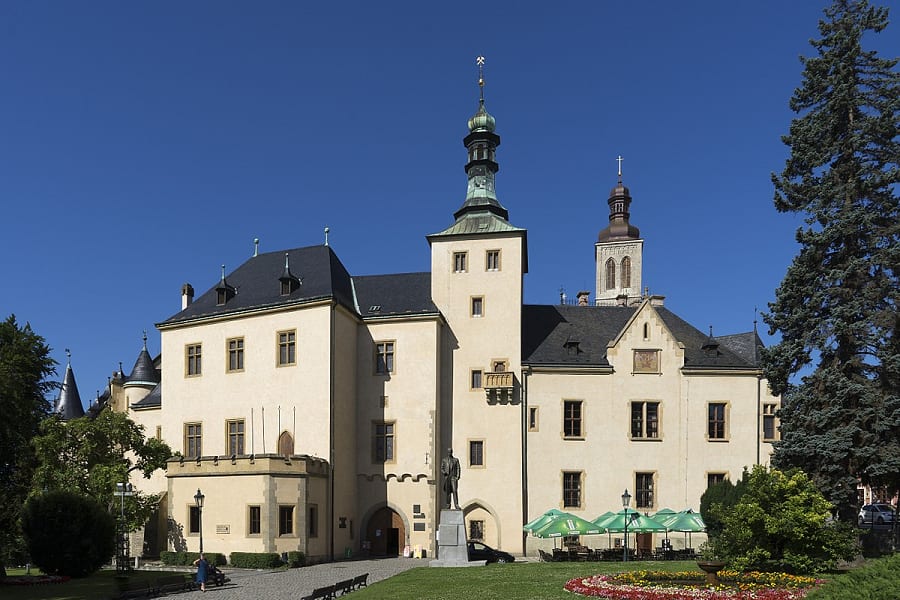
Italian Court
 Highlight of Kutna Hora
Highlight of Kutna HoraVisit a museum of coin minting located in a former royal palace.
This grand building is the former royal mint and a residence of the kings of Bohemia from the 13th century. It has served as the town hall since the 19th century. You can visit a coin exhibit, see a coiner stamping coins, and tour the former royal palace, including a beautiful Art nouveau chapel filled with valuable wooden altars.

The Stone House
 Highlight of Kutna Hora
Highlight of Kutna HoraTake a peak at a richly decorated family house built in medieval times.
In addition to admiring the home from outside, you can visit two museum expositions: Bourgeois Culture and Life in Kutná Hora between 17th and 19th century, and a lapidary showing the structural development of the town.
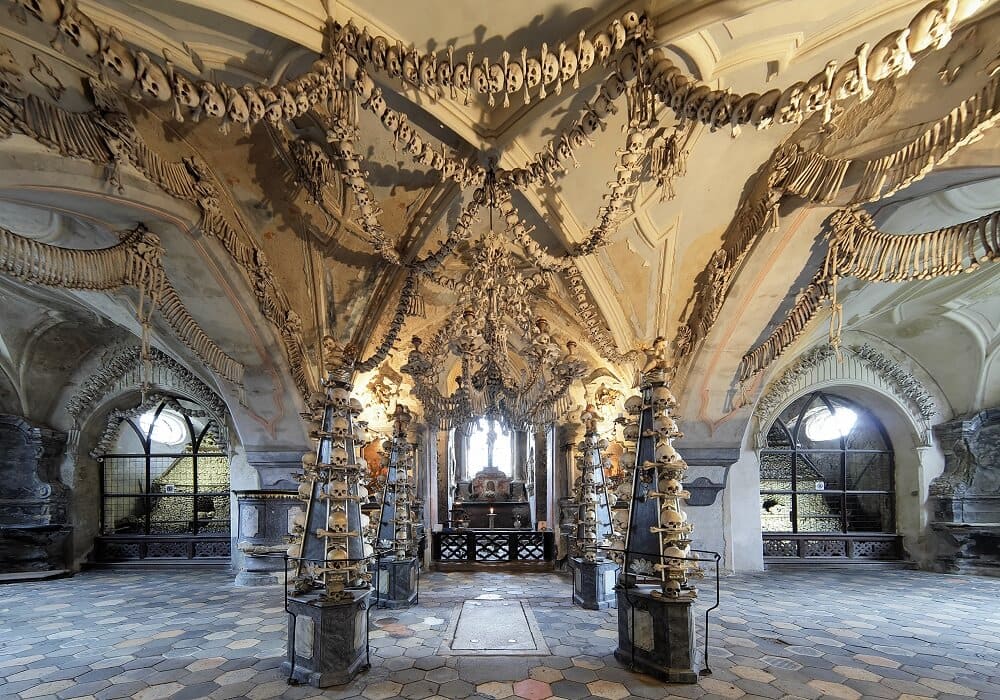
Sedlec Ossuary
 Highlight of Kutna Hora
Highlight of Kutna HoraConfront your own mortality in the crypt of a small Gothic church decorated with garlands of human skulls, plus a bone chandelier & chalices.
As macabre as it might appear, one cannot help but admire the imaginative ways in which thousands of human bones have been put to decorative use. There's everything from huge pyramids of skulls, to a chandelier to an aristocratic coat of arms composed of the remains of those who sought their final resting place in Sedlec. It’s a breath-taking reminder of the medieval practice of reflecting on mortality, summed up in the Latin expression ‘Memento mori’ or ‘remember you must die’.

St Barbara's Church
 Highlight of Kutna Hora
Highlight of Kutna HoraSee a spectacular church decorated with sharp spines, flying buttresses & frescoes.
The church, which many mistake for a cathedral, is the exquisite result of a centuries-long struggle for autonomy in religious affairs that raged between Kutná Hora and the nearby Cistercian monastery. The church was built outside of the town walls, but on land not owned by the monastery, as a symbol of the city's independence from the monastery. It was fittingly dedicated to St. Barbara, the miners' patron saint.

Italian Court
 Highlight of Kutna Hora
Highlight of Kutna HoraVisit a museum of coin minting located in a former royal palace.
This grand building is the former royal mint and a residence of the kings of Bohemia from the 13th century. It has served as the town hall since the 19th century. You can visit a coin exhibit, see a coiner stamping coins, and tour the former royal palace, including a beautiful Art nouveau chapel filled with valuable wooden altars.

The Stone House
 Highlight of Kutna Hora
Highlight of Kutna HoraTake a peak at a richly decorated family house built in medieval times.
In addition to admiring the home from outside, you can visit two museum expositions: Bourgeois Culture and Life in Kutná Hora between 17th and 19th century, and a lapidary showing the structural development of the town.

Sedlec Ossuary
 Highlight of Kutna Hora
Highlight of Kutna HoraConfront your own mortality in the crypt of a small Gothic church decorated with garlands of human skulls, plus a bone chandelier & chalices.
As macabre as it might appear, one cannot help but admire the imaginative ways in which thousands of human bones have been put to decorative use. There's everything from huge pyramids of skulls, to a chandelier to an aristocratic coat of arms composed of the remains of those who sought their final resting place in Sedlec. It’s a breath-taking reminder of the medieval practice of reflecting on mortality, summed up in the Latin expression ‘Memento mori’ or ‘remember you must die’.

St Barbara's Church
 Highlight of Kutna Hora
Highlight of Kutna HoraSee a spectacular church decorated with sharp spines, flying buttresses & frescoes.
The church, which many mistake for a cathedral, is the exquisite result of a centuries-long struggle for autonomy in religious affairs that raged between Kutná Hora and the nearby Cistercian monastery. The church was built outside of the town walls, but on land not owned by the monastery, as a symbol of the city's independence from the monastery. It was fittingly dedicated to St. Barbara, the miners' patron saint.
prev
next


Day 10
Depart Prague
Day 10
Depart Prague

To Be Determined
Transfer to Prague Airport by Private Car
A car service will pick you up from the N/A at the time listed above, and deliver you to the Prague Airport for your flight departure. This is a private transfer just for your travel party, and you will not need to pay the driver for the transfer, as it is already included in the cost of the itinerary.

Day 10
Depart Prague


What's Included In Your Trip

Pre-Paid Tours and Activities:
- Walking Tour of Split Old Town & Diocletian's Palace
- Highlights of Zagreb, Guided Tour
- Best of Budapest: Half-Day Walking Tour of Highlights & Hidden Finds
- Prague Castle & Royal Route Guided Walk

Pre-Paid Transportation:
- 2nd Class Train Tickets from Split-Zagreb
- 2nd Class Train Tickets from Zagreb-Budapest
- 2nd Class Train Tickets from Budapest to Prague
- Arrival in Split and Private Transfer to Hotel from Airport
- Arrival in Zagreb and Private Transfer to Hotel
- Private Transfer from the Budapest Rail Station
- Private Transfer to Rail Station in Budapest
- Transfer to Prague Airport by Private Car

Accommodation:
- 4 nights at a hotel of your choice in Split
- 2 nights at a hotel of your choice in Zagreb
- 3 nights at a hotel of your choice in Budapest
- 4 nights at a hotel of your choice in Prague

Go Real Travel Mobile App:
- Itinerary Plan & Reservations Info
- Points of Interest
- Detailed Travel Information
- Maps & Directions
Other Trips You May Like

12 Days
From$2675USD
Jewish Heritage and Scenic Rivers: A Journey through Prague, Vienna, and Budapest

Hungary, Austria, Czech Republic

10 Days
From$1927USD
Rivers and Revelries in the Cultural Capitals of Central Europe - Berlin, Prague & Budapest

Germany, Czech Republic, Hungary

12 Days
From$2200USD
A 12-Day Prague, Vienna, Budapest, and Bratislava Itinerary

Czech Republic, Austria, Slovakia, Hungary

10 Days
From$2249USD
Perfect Whirlwind Itinerary to Prague, Salzburg, Vienna & Budapest

Czech Republic, Austria, Hungary

14 Days
From$2350USD
Imperial Elegance: Prague, Vienna and Budapest Itinerary 14 Days

Czech Republic, Austria, Hungary

7 Days
From$1489USD

8 Days
From$1585USD

15 Days
From$2750USD
Prague, Vienna, and Budapest, 15 Days of Must See Sights & Local Scenes

Czech Republic, Austria, Hungary

8 Days
From$1425USD
Enchanting Central Europe: 8-Days in Prague, Vienna & Budapest

Czech Republic, Austria, Hungary

12 Days
From$2675USD
Jewish Heritage and Scenic Rivers: A Journey through Prague, Vienna, and Budapest

Hungary, Austria, Czech Republic

10 Days
From$1927USD
Rivers and Revelries in the Cultural Capitals of Central Europe - Berlin, Prague & Budapest

Germany, Czech Republic, Hungary

12 Days
From$2200USD
A 12-Day Prague, Vienna, Budapest, and Bratislava Itinerary

Czech Republic, Austria, Slovakia, Hungary

10 Days
From$2249USD
Perfect Whirlwind Itinerary to Prague, Salzburg, Vienna & Budapest

Czech Republic, Austria, Hungary

14 Days
From$2350USD
Imperial Elegance: Prague, Vienna and Budapest Itinerary 14 Days

Czech Republic, Austria, Hungary

7 Days
From$1489USD

8 Days
From$1585USD

15 Days
From$2750USD
Prague, Vienna, and Budapest, 15 Days of Must See Sights & Local Scenes

Czech Republic, Austria, Hungary

8 Days
From$1425USD
Enchanting Central Europe: 8-Days in Prague, Vienna & Budapest

Czech Republic, Austria, Hungary
prev
next
Featured Blogs
prev
next
Our Customers Say It Best
Marianne Strydom, Paarl, South Africa
I just wanted to thank you for organizing an amazing trip for me – I packed in so much in such a short period of time and everything was just perfect. The way you do things makes it possible to really get to know the destination, which for me as a travel agent could not have been better. 

Otto Chuy, Los Angeles, California
I am still surprised how everything worked as planned, without a hitch. All instructions in your itinerary were precise and correct. Your suggestions and comments in each of the locations we went to were very helpful. All your guides, without exception, were wonderful and exactly on time. 

Malini Dutta, Boston, Massachusetts
We can't thank you enough for the detailed plans, maps, and suggestions. It really felt that someone was holding our hands and showing us around. We had all the excitement of discovering foreign lands, with none of the problems that can happen while negotiating unfamiliar places. In fact, all the cities felt like home within a few hours of arriving and exploring. 

Bev and Mark Frankel, Williamsburg, Virginia
We could not be more pleased with Go Real Travel! You took the guess work out of things like public transport but still managed to allow us the freedom to tour as we wanted. Our guides were exceptional and every time I saw a Viking Cruise tour of 25 people, I realized the quality experience we were getting with Go Real. 

Marianne Strydom, Paarl, South Africa
I just wanted to thank you for organizing an amazing trip for me – I packed in so much in such a short period of time and everything was just perfect. The way you do things makes it possible to really get to know the destination, which for me as a travel agent could not have been better. 

Otto Chuy, Los Angeles, California
I am still surprised how everything worked as planned, without a hitch. All instructions in your itinerary were precise and correct. Your suggestions and comments in each of the locations we went to were very helpful. All your guides, without exception, were wonderful and exactly on time. 

Malini Dutta, Boston, Massachusetts
We can't thank you enough for the detailed plans, maps, and suggestions. It really felt that someone was holding our hands and showing us around. We had all the excitement of discovering foreign lands, with none of the problems that can happen while negotiating unfamiliar places. In fact, all the cities felt like home within a few hours of arriving and exploring. 

Bev and Mark Frankel, Williamsburg, Virginia
We could not be more pleased with Go Real Travel! You took the guess work out of things like public transport but still managed to allow us the freedom to tour as we wanted. Our guides were exceptional and every time I saw a Viking Cruise tour of 25 people, I realized the quality experience we were getting with Go Real. 



Explore cities in more detail

Prague
The city of Prague is indisputably the gem of Central Europe. Full of history, culture, and classic Czech pubs around every corner, Prague is teeming with nooks and crannies just waiting to be discovered. The narrow cobblestone streets and warm red rooftops give the city a homey feel, while the well-preserved medieval architecture transports you back in time. Walking across the Charles Bridge with the view of the Prague Castle will make you feel like you’re living in a fairytale, and you might as well be. As an up-and-coming destination, Prague is a perfect mix of classic and modern. New trendy cafes and bistros are always popping up, and you can always find a group of lively locals chowing down on goulash and quaffing pivo (the best beer in Europe!) at traditional Czech restaurants across the city. The clash of modernity and tradition, preservation and innovation, gives this city a mysterious air that you won’t soon forget.

Learn About Prague
Build Prague Trip
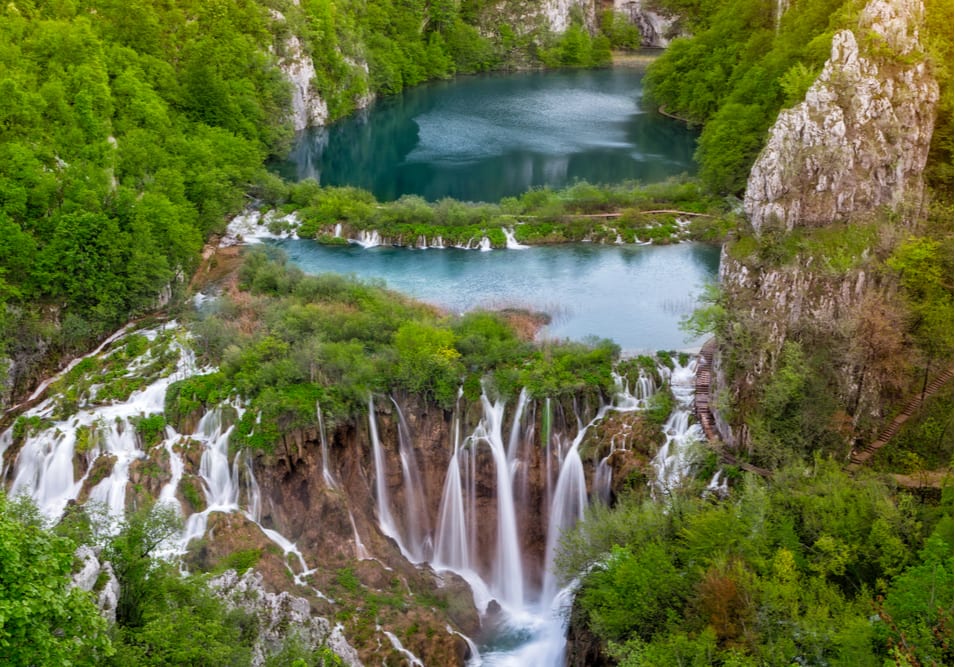
Plitvice Lakes
Plitvice Lakes in Croatia is a national park featuring 16 interconnected lakes. It was once one of Yugoslavia’s most popular tourist hotspots, and today this UNESCO World Heritage Site attracts visitors from all over the world. The lakes’ main draw is their sublime natural beauty. Turquoise pools, joined by a series of waterfalls and cascades, are set like jewels within the park’s lush green hillsides. Wooden hiking paths snake between the lakes and along the shores. Plitvice hosts an impressive variety of wildlife, from wild boars and dormice to hundreds of butterfly species, and countless types of birds. The park’s most famous resident is the elusive brown bear. Occupied by hostile forces during the Croatian War of Independence, this park’s history isn’t all paradisical. However, it’s easy to forget that troubled past when spending time by the lakes today. Today, Plitvice’s mood is all about peace, relaxation, and appreciation of stunning natural beauty.

Learn About Plitvice Lakes
Build Plitvice Lakes Trip

Dubrovnik
Situated in southern Croatia on the Adriatic Sea, Dubrovnik is famous for many different reasons. Everywhere you look in Dubrovnik is a stunning view. Known for its beautiful Old Town and ancient walls, Dubrovnik is a resilient city that deserves its nickname as the pearl of the Adriatic. Strolling through the limestone streets lined with baroque buildings, alongside the animated locals, will inspire you to keep exploring. The city walls offer spectacular views of the red rooftops in Old Town and the shimmering blues of the Adriatic Sea. After a tiring trek in the hot Croatian sun, cool off at one of Dubrovnik’s divine pebbly beaches and go swimming in the sea. The best way to end the day is a visit to Stradun, the main street, to pop into one of the cafes or restaurants, and relax during a delicious meal of Croatian specialties and wine.

Learn About Dubrovnik
Build Dubrovnik Trip

Split
A lively port city situated between mountains and sea, Split is one of Croatia's most visited—and most beautiful— cities. With historical monuments sprinkled across the Dalmatian coastline and trendy cafes and shops popping up within the ancient walls of the city center, it's easy to see why this extraordinary city is such a popular travel destination. Split is always abuzz with visitors and locals alike enjoying a seafood meal outside, relaxing on the beach, or boating on the Adriatic. The weather is almost always beautiful, so the streets tend to be crowded with people looking to take advantage of the sunshine. A walk through Split feels like a journey through past centuries. The coastal town showcases modern architecture next to structures like Diocletian's Palace, which date back to the times of the Roman Empire. In fact, Split's Old Town resides within the walls of Diocletian's Palace. As you stroll through the narrow marble streets, you'll be amazed by the number of modern restaurants and bars populating this ancient area. It's easy to pack plenty of culture, history, activity, and leisure all into one amazing trip.

Learn About Split
Build Split Trip

Zagreb
Zagreb is Croatia's biggest city, known for its cultural roots and vibrant street life. The city's rich history is evident in the mix of different architectural styles, including secessionist, classical, neo-Baroque, neo-Gothic, and art deco. Even the seemingly lackluster parts of town have been brought to life by street artists. At first glance, the red rooftops and cobblestone streets might seem reminiscent of other popular European cities, but you'll soon learn that Zagreb has a spirit all its own. Everywhere you go, you'll be rubbing elbows with lively locals hanging out at open cafes, gardens, and parks, or rushing to the next event on the calendar. Thanks to the spacious pedestrian zones attracting locals, expats, and visitors alike, socializing with new people and finding something unexpected to do is effortless. At night, the youth of the city becomes even more exuberant. With plenty of jazz clubs, beer halls, cocktail bars, and casinos, there's always something to do because the city never sleeps.

Learn About Zagreb
Build Zagreb Trip
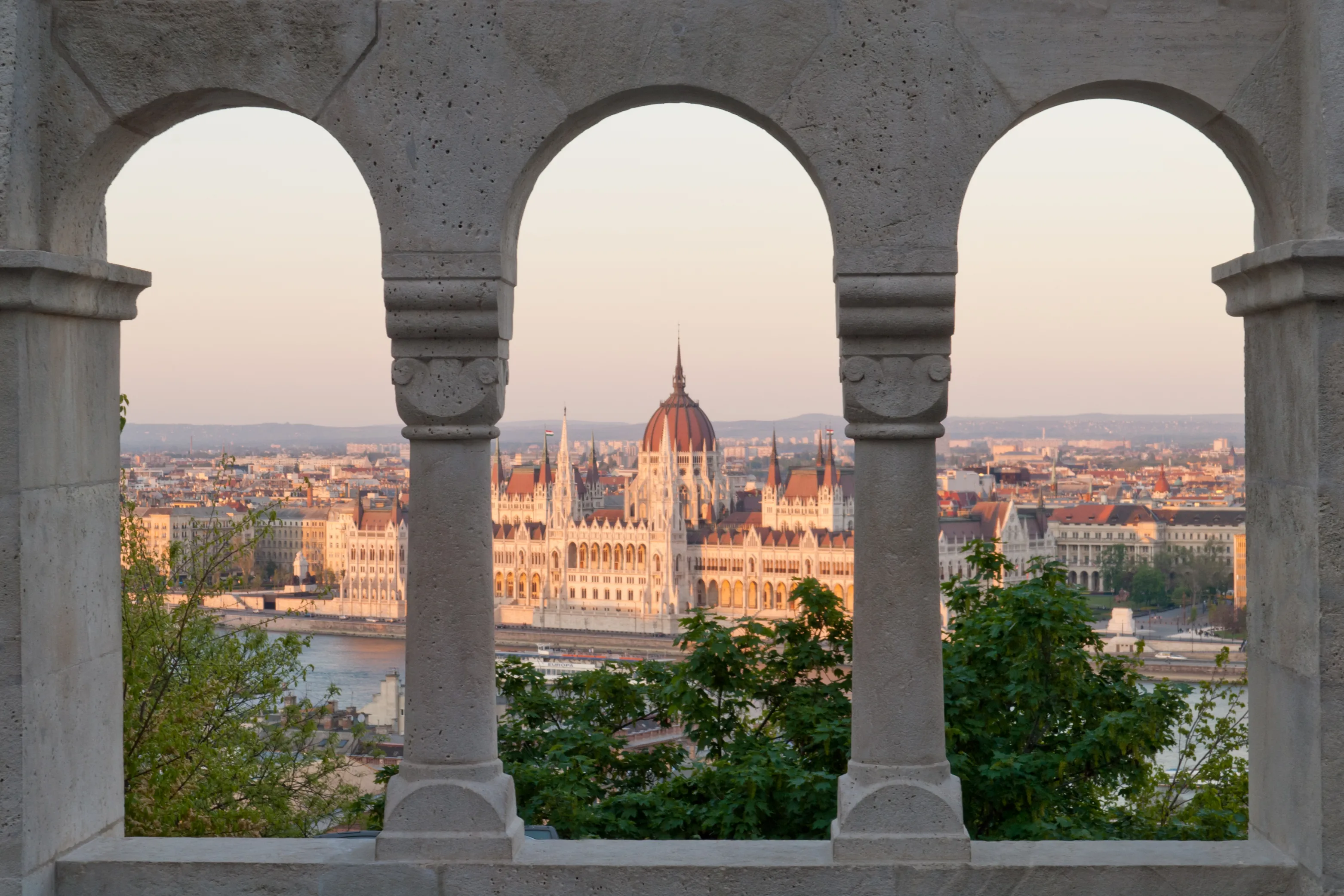
Budapest
Situated at the heart of Europe, Budapest is the capital of Hungary, appropriately named 'The Pearl of the Danube,' for its fixating and almost haunting beauty. Formerly two separate cities, Buda and Pest were forged into one by time, occupation, and the eight bridges that anchor them together today. From the Romans to the Communists, each occupier left its flavor profile in Budapest, evident in the famous spicy Hungarian stew known as 'goulash.' Budapest is a melting pot of history, culture, and taste, from the magnificent Baroque and neo-Gothic architecture to the Turkish thermal baths. After a long day of sightseeing, treat yourself to a glass of Tokaj, what King Louis XIV of France referred to as the "Wine of Kings, King of Wines". Budapest has a flavor to satisfy any taste.

Learn About Budapest
Build Budapest Trip

Prague
The city of Prague is indisputably the gem of Central Europe. Full of history, culture, and classic Czech pubs around every corner, Prague is teeming with nooks and crannies just waiting to be discovered. The narrow cobblestone streets and warm red rooftops give the city a homey feel, while the well-preserved medieval architecture transports you back in time. Walking across the Charles Bridge with the view of the Prague Castle will make you feel like you’re living in a fairytale, and you might as well be. As an up-and-coming destination, Prague is a perfect mix of classic and modern. New trendy cafes and bistros are always popping up, and you can always find a group of lively locals chowing down on goulash and quaffing pivo (the best beer in Europe!) at traditional Czech restaurants across the city. The clash of modernity and tradition, preservation and innovation, gives this city a mysterious air that you won’t soon forget.

Learn About Prague
Build Prague Trip

Plitvice Lakes
Plitvice Lakes in Croatia is a national park featuring 16 interconnected lakes. It was once one of Yugoslavia’s most popular tourist hotspots, and today this UNESCO World Heritage Site attracts visitors from all over the world. The lakes’ main draw is their sublime natural beauty. Turquoise pools, joined by a series of waterfalls and cascades, are set like jewels within the park’s lush green hillsides. Wooden hiking paths snake between the lakes and along the shores. Plitvice hosts an impressive variety of wildlife, from wild boars and dormice to hundreds of butterfly species, and countless types of birds. The park’s most famous resident is the elusive brown bear. Occupied by hostile forces during the Croatian War of Independence, this park’s history isn’t all paradisical. However, it’s easy to forget that troubled past when spending time by the lakes today. Today, Plitvice’s mood is all about peace, relaxation, and appreciation of stunning natural beauty.

Learn About Plitvice Lakes
Build Plitvice Lakes Trip

Dubrovnik
Situated in southern Croatia on the Adriatic Sea, Dubrovnik is famous for many different reasons. Everywhere you look in Dubrovnik is a stunning view. Known for its beautiful Old Town and ancient walls, Dubrovnik is a resilient city that deserves its nickname as the pearl of the Adriatic. Strolling through the limestone streets lined with baroque buildings, alongside the animated locals, will inspire you to keep exploring. The city walls offer spectacular views of the red rooftops in Old Town and the shimmering blues of the Adriatic Sea. After a tiring trek in the hot Croatian sun, cool off at one of Dubrovnik’s divine pebbly beaches and go swimming in the sea. The best way to end the day is a visit to Stradun, the main street, to pop into one of the cafes or restaurants, and relax during a delicious meal of Croatian specialties and wine.

Learn About Dubrovnik
Build Dubrovnik Trip

Split
A lively port city situated between mountains and sea, Split is one of Croatia's most visited—and most beautiful— cities. With historical monuments sprinkled across the Dalmatian coastline and trendy cafes and shops popping up within the ancient walls of the city center, it's easy to see why this extraordinary city is such a popular travel destination. Split is always abuzz with visitors and locals alike enjoying a seafood meal outside, relaxing on the beach, or boating on the Adriatic. The weather is almost always beautiful, so the streets tend to be crowded with people looking to take advantage of the sunshine. A walk through Split feels like a journey through past centuries. The coastal town showcases modern architecture next to structures like Diocletian's Palace, which date back to the times of the Roman Empire. In fact, Split's Old Town resides within the walls of Diocletian's Palace. As you stroll through the narrow marble streets, you'll be amazed by the number of modern restaurants and bars populating this ancient area. It's easy to pack plenty of culture, history, activity, and leisure all into one amazing trip.

Learn About Split
Build Split Trip

Zagreb
Zagreb is Croatia's biggest city, known for its cultural roots and vibrant street life. The city's rich history is evident in the mix of different architectural styles, including secessionist, classical, neo-Baroque, neo-Gothic, and art deco. Even the seemingly lackluster parts of town have been brought to life by street artists. At first glance, the red rooftops and cobblestone streets might seem reminiscent of other popular European cities, but you'll soon learn that Zagreb has a spirit all its own. Everywhere you go, you'll be rubbing elbows with lively locals hanging out at open cafes, gardens, and parks, or rushing to the next event on the calendar. Thanks to the spacious pedestrian zones attracting locals, expats, and visitors alike, socializing with new people and finding something unexpected to do is effortless. At night, the youth of the city becomes even more exuberant. With plenty of jazz clubs, beer halls, cocktail bars, and casinos, there's always something to do because the city never sleeps.

Learn About Zagreb
Build Zagreb Trip

Budapest
Situated at the heart of Europe, Budapest is the capital of Hungary, appropriately named 'The Pearl of the Danube,' for its fixating and almost haunting beauty. Formerly two separate cities, Buda and Pest were forged into one by time, occupation, and the eight bridges that anchor them together today. From the Romans to the Communists, each occupier left its flavor profile in Budapest, evident in the famous spicy Hungarian stew known as 'goulash.' Budapest is a melting pot of history, culture, and taste, from the magnificent Baroque and neo-Gothic architecture to the Turkish thermal baths. After a long day of sightseeing, treat yourself to a glass of Tokaj, what King Louis XIV of France referred to as the "Wine of Kings, King of Wines". Budapest has a flavor to satisfy any taste.

Learn About Budapest
Build Budapest Trip
prev
next


 Map of Your Itinerary Route
Map of Your Itinerary Route
Zoom In to the cities to see your itinerary in more detail


 4.8
4.8 






